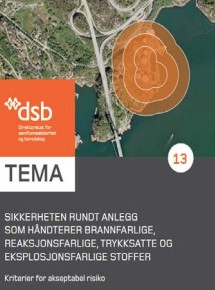Land-Use Planning Around an Existing Hazardous Facility, Sarpsborg
 |
Sub-title: Communicating the risks to the public, and coordination between the local planner, the national authority and the operator
Country: Norway
Date: 2016
Category: Plans, Policies, Measures
Tags: Land-Use Planning, Industrial Safety, Public Participation, Public Access to Information
Organization(s) involved: Borregaard and Norwegian Directorate for Civil Protection
In 2016, the local government proposed a revision of the land use plan for the city of Sarpsborg in Norway. The revision included proposals for new urban development and densification of existing residential areas (from low-rise housing to apartment blocks) to accommodate a growth in population of the city by 40 % over the next decade. A major challenge that they faced related to an existing hazardous facility located within the city – the Borregaard cellulose factory that utilizes large amounts of sulphur dioxide. If an accident were to occur, the toxic gas could have significant health impacts on the surrounding urban areas. Therefore, it was decided to introduce new consideration zones in existing residential areas, and to involve the public in the process. Norway has a number of regulations to ensure that the safety of the public is considered around hazardous industrial facilities, including the Planning and Building Act and the Fire and Explosion Prevention Act. The two acts are the legal framework for the national policy on siting of major hazard installations, created in line with article 7 of the UNECE Industrial Accidents Convention on decision-making on siting. The city of Sarpsborg sought to strengthen their planning procedures by actively engaging the public and other stakeholders in the process, by providing clear information in a timely manner, and by listening and responding to the public’s views.
Key lessons learned: In this case, it was acknowledged that a lengthy and transparent planning and public participation process led to positive outcomes between members of the public, stakeholders, industrial operators, developers and the government. Through the planning process, the members of the public of the city of Sarpsborg were actively engaged in identifying the advantages and disadvantages of the draft land use plan and the proposed urban developments, and they played an active role in securing a safer environment in the vicinity of the hazardous industrial facility. This process and the public’s input were crucial in order to achieve sustainable land use management in the long term, in line with SDGs 3, 11 and 16, the Sendai Framework for Disaster Risk Reduction, and the relevant UNECE instruments.
Further details: See the Presentation by DSB of Norway at the UNECE Seminar on land-use planning and industrial safety, Mechelen, Belgium, 2018
For information about the EIB and UNECE Information Repository of Good Practices and Lessons Learned in Land-Use Planning and Industrial Safety and to access case studies from other countries, please visit the navigation page.

